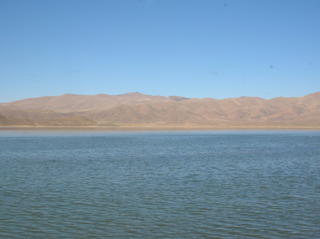Things I learned while in Bolivia:
1) tons of Bolivian slang (including some Aymara and Quechua words)
2) what real development is all about (change of beliefs and traditions) and how hard the real development work is
3) how awesome fruit and vegetables grown without chemicals can taste
4) that I absolutely love steak
5) how to tell apart llama, alpaca, and vicuna
6) that there are Russians in every corner of this planet
7) how to survive in a fairly cold climate
8) what real Christian hospitality and kindness are like
9) that my favorite method of public transportation is definitely the train
10) that I ABSOLUTELY love to travel!!!

Last Day
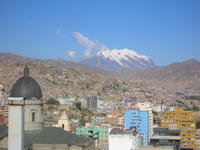
I started getting a little teary eyed the day before, on the train, looking out of the window on the unforgettable altiplano and the mountains and realizing that I wasn’t going to see this scenery anymore. Good thing that the last day was very busy…the three of us (Sara, Meg, and I) left the house early to finish some last minute shopping, introduce Meg to saltenas (typical Bolivian food), and to tour the beautiful church of San Francisco, which turned out to be a very enlightening tour during which I learned a lot about the history of Bolivia, La Paz, and the Catholic Church in Latin America. Souvenir shopping was quick and crazy (soooo much stuff to choose from), and packing was even worse (why do I always bring so much stuff when I travel???) At night we hung out the family, ate pizza, and took some last-minute pictures, battling with the self-timer function on my camera. After sleeping about 2 hours, we left at 4am for the airport, and about 7am our plane got in the air, leaving the beautiful country that I grew to love behind.(The pictures are of the view of La Paz and Illimani (the mountain) from a overlook platform at a hotel and of the family I stayed with).
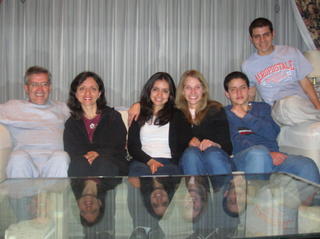
Salar de Uyuni (contd)
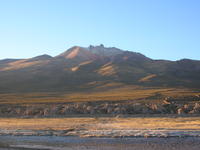
Thursday/Friday
Waking up at the crack of dawn and eating yet another delicious breakfast, prepared by our guide’s wife, we first went to see some interesting mummies left almost untouched from the pre-Inca times and then embarked on a strenuous hike to the mid-section of the volcano Tunupa…let me tell you, considering it was already in very high altitudes with wind and bright sun, it really took some effort to complete this hour and a half climb…upon reaching an overlook place, we were rewarded for our efforts by a gorgeous and tranquil view of the volcano and the surrounding valley ( and we also saw some llamas on the way there, which was my last chance to be close to them and try petting them that is almost impossible since they are very timid). Needless to say, the walk back took us twice less the time it took us to climb up and after lunch, we began our journey back to Uyuni. On the way we saw some more of the Salar, got to see how salt is processed, toured the Hotel del Sal (hotel made completely of salt), and visited the Ojos del Sal (“eyes of the salt,” holes in the middle of the salt field with bubbling water caused by the water pressure of the rivers underneath the surface). Near Uyuni, we also visited the “Cementerio de Trenes,” a place with tons of old locomotives.
Oh but the “best part” was yet to come…we were supposed to leave on the train back to Oruro at around 1:30 am Friday morning…we showered and rested a bit at the hotel, packed our bags, checked out of the hotel, and walked to the train station at around 1am. When we got there, there were surprisingly very few people, and an Argentinian couple sadly told us, “No hay tren,” which simply means, “there is no train.” It turned out that due to some mechanical problems, the train was delayed till 9:00am or so the next morning. Dumbfounded, we opted to return to the hotel and sleep there for a few hours before returning to the station. After a night of nightmares of missing the train, we woke up early the next morning to ensure us getting on that train if it came any earlier…We did get on it, but not until 11am. Even though I was exhausted, I realized that this was my last chance to see the beautiful altiplano, with its unique scenery and, of course, the llamas, so I stayed awake most of the train ride gazing out of the window and taking a million pictures of the surroundings.
Right off the train in Oruro, we were greeted by frantic cab drivers telling us that there was a road blockade between Oruro and La Paz and that we better hurry if we want to make it to the last bus leaving for La Paz. The prospect of spending a night in this sad and quite detestable town really scared us, so we jumped in the first taxi, and even though the driver drove like a maniac, we did make it to the only bus leaving for La Paz. To our great relief, the road blockade has disseminated by then, and about 3.5 hours later, we were picked up by Sara’s parents and in about 30 more minutes we were finally HOME! (The pictures are of the volcano from the top and me at the overlook, and the girls sitting on a plaza in Uyuni waiting for the train).
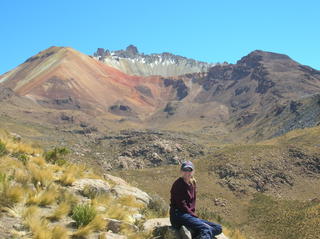
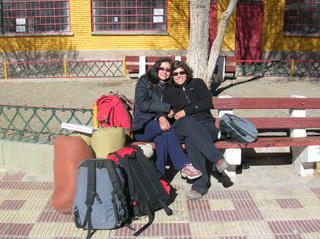
Salar de Uyuni (contd)
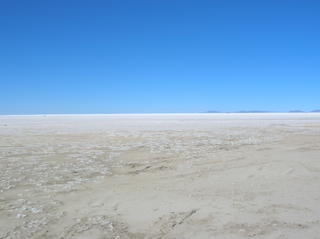
Wednesday
In the morning after having breakfast with the most delicious bread I have ever had (called el pan del pueblo), we were picked up by our tour guide in a 4x4 Toyota SUV and along with a French couple, embarked on our journey to the Salar. On the way there, I finally saw some vicuñas, the third camelid found in Bolivia…they were very different from llamas and alpacas…skinnier and with longer neck. This animal has not been domesticated and lives in the wild, but is protected by the Bolivian government.
The Salar was truly an incredible sight…it looked like a huge white sea or the Arctic…everywhere you looked, there was salt surrounded by mountains. This is the largest salt deposit in the world…it stretches for 12,000 square km…Bolivians export salt to several neighboring countries. It was interesting to learn that only the people from the small town of Colchani, located on one “shore” of Salar have the right to work there…they gather the salt into small piles, transport it back to the town, grind it, add iodine, package it, and ship it out.
Our next stop was Incahuasi (or La Isla del Pescado), a coral-like reef right in the salt field that from far away looks like a giant fish. The most unique thing was that the island was completely covered in giant cacti…we could barely believe our eyes. We walked to the top of the island to enjoy an incredible view of the salar, and then ate a delicious lunch prepared by our guide’s wife right there on the island.
After lunch we went to a very unique cave called Galaxy discovered only 3 years ago by Italian archeologists looking for pre-Incan mummies…the inside was composed of dried-up volcanic ash that took very unusual shapes. The next stop just next door was to the Cementerio de Chulpas (mummy cementery), except that either the indigenous people hid their dead from the Spaniards or the Spaniards stole all the mummies (since people were usually buried with most of their earthly possessions).
Then we headed off to our final destination that day…a small village at the feet of Volcano Tunupa, also located in the salar. Right upon the entrance, we saw another breathtaking sight…flamingos, lots of them, just hanging out at the water puddles in the salar…it was unbelievable to see such an exotic bird, which I always associated with tropical parts of Florida, right there, in the midst of the cold salt field. The next pleasant surprise was seeing lots of llamas at the entrance to our lodgings. The unpleasant surprise that followed was discovering how humble our accommodations were..we barely had a roof and no running water and electricity by generator (mind you, we were in the midst of the cold altiplano). Well, cheered up a little by Meg and Sara, I decided that I could indeed survive one night there, and took advantage of the remaining daylight to try to get close to the llamas and flamingos, both of which I succeeded in doing and got some great pictures. After dinner, we discovered that we only had light till 9pm, but actually weren’t as cold as I imagined when we went to bed in the anticipation of new exciting adventures. (The pictures are of the Salar, the three of us standing on a pile of salt, and flamingos)
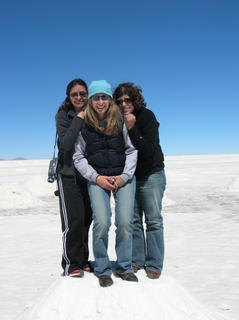

Salar de Uyuni
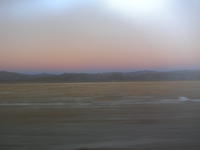
Tuesday
Sara, Meg, and I got on the bus to Oruro, a sad miner’s town that I have visited earlier in the summer (3 hours south of La Paz) to take a train to the department of Potosi to the small town of Uyuni where the Salar (large salt field) is. The train ride was rather comfortable even though it was 7 hours long. We saw the magnificent Andes mountains and the flora of the altiplano and also got a chance to see Lake Poopo, the second largest lake in Bolivia. Upon arrival to Uyuni, we went to our hotel, which was right across the train station and went straight to bed. It was rather cold in this town as it is located in one of the coldest areas in Bolivia, so we had to get into our sleeping bags underneath the bed covers. (the pictures are of the altiplano at dusk (above) and of Lake Poopo (below).
